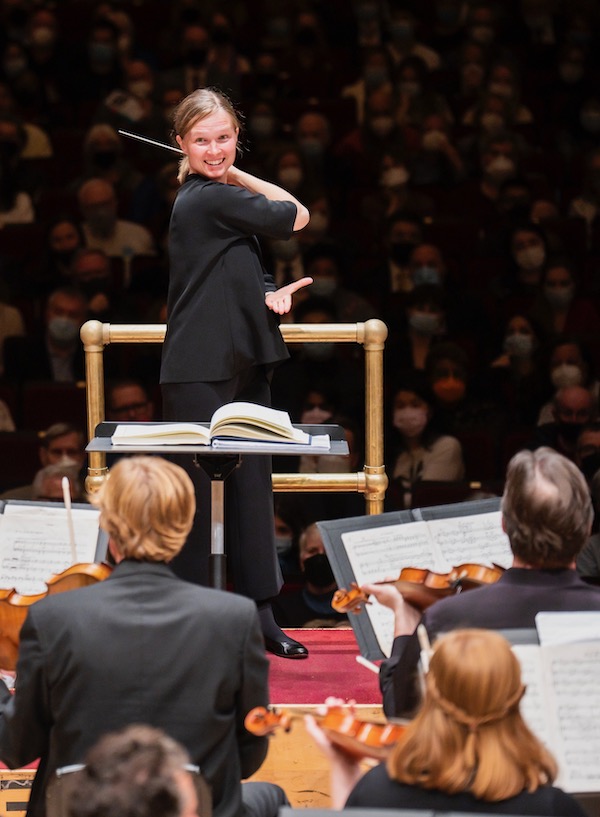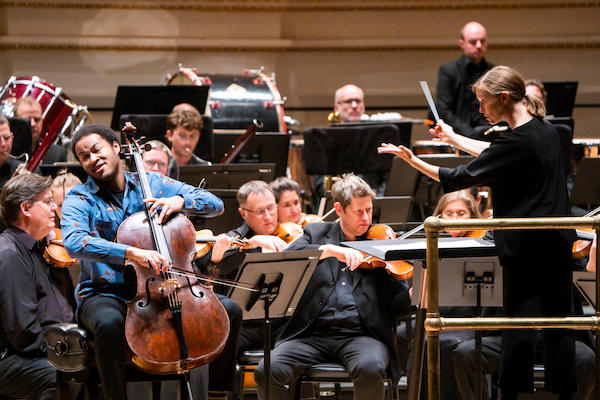Adès’ music highlights City of Birmingham Symphony program at Carnegie

A few years back, this writer encountered a piece called The Lord of the Rings Symphony, which was being programmed by quite a few orchestras around the country. In it the composer Howard Shore had strung together a few of the tracks he’d written for those films, but the result wasn’t anything one could really call a symphony. It might have been titled The Lord of the Rings Original Soundtrack Album, if there weren’t already something called that.
There was a feeling of déja vu as the New York premiere of Thomas Adės’s The Exterminating Angel Symphony got under way Saturday night at Carnegie Hall, in what the Brits might call a smashing performance by the City of Birmingham Symphony Orchestra under its principal guest conductor, Mirga Gražinytė-Tyla.
One by one, up popped the set pieces from Adės’s 2017 opera based on the classic surrealist film by Buñuel: “Entrance,” introducing the doomed socialites in Act I; “March,” the fiercely sardonic entr’acte after their party goes strangely awry; “Berceuse,” a rare moment of tenderness in a lovers’ duet. For all their lurid brilliance, all three sounded like what they were–transitional music, not symphonic movements.
The last movement, “Waltzes,” was a different animal—“something wholly original,” as the composer put it, concocted from “waltz fragments that surface throughout the score.” He did not go on to say he had updated Ravel’s La Valse by a hundred years, but that was the effect of this striking composition, with its mingled yearning, tenderness, irony, and feeling of doom. So, in the end, this opera suite had a satisfyingly symphonic finale to justify its title.
Gražinytė-Tyla, who at 36 recently stepped down as music director of this launching pad for future notables—her predecessors included Simon Rattle and Andris Nelsons—was alert to every mood in Adès’s score, from the drag-them-down-to-hell chromatics of “Entrance” to the snare drum-driven, Shostakovichian crescendos of “March” to the icy tissue of high flutes and violins in “Berceuse.” An unremitting feeling of menace ran through the shifting moods of “Waltzes.”
Earlier, the conductor’s distinctive presence on the podium all but upstaged soloist Sheku Kanneh-Mason in the evening’s opening work, Elgar’s Cello Concerto. As rooted and centered as a tree in the wind, Gražinytė-Tyla spoke volumes with her hands and arms, the latter partly exposed by the three-quarters sleeves of her simple black tunic. It was hard to take one’s eyes off her fluid but eloquent gestures, especially as the soloist was not exactly signaling for attention.

Kanneh-Mason’s approach was engaged and insightful, but less showy than one typically encounters with this passionate, tragic late work. His opening statement was less a cri de coeur than a melancholy reflection, and his sound seemed to withdraw into the orchestra at some points. But as one’s ears settled into his and Gražinytė-Tyla’s conception of the piece, the performance became a kind of un-concerto, with the cellist as first among equals in a joint effort.
Which is not to say Kanneh-Mason didn’t sparkle in the second movement’s scherzando interlude, or step out smartly in the march-like finale. The latter movement lost some expressive tension, however, as Gražinytė-Tyla leaned back—literally, against the podium’s brass railing—instead of into the fervent crescendos. (For an encore, Kanneh-Mason and four cellists from the orchestra performed his own sonorous arrangement of a Bach chorale, “Come, Sweet Death.”)
She was on her toes, however, for Debussy’s La mer, which closed the concert with elemental imagery that brought a full-body response from the conductor. Precise as ever in her directions, she also sustained the tension of the ocean’s natural forces, which paid off in spectacular climaxes as the music grew “From Dawn to Noon on the Sea.”
The second movement, “Play of the Waves,” might have been called “Play of the Percussion and Woodwinds,” as the orchestra’s sections mixed to ravishing effect, most notably in the pianissimo passages, with their puffs of breeze and flinging droplets.
Those elements grew to vast proportions in the closing “Dialogue of the Wind and the Sea,” whose minor-major motto theme epitomized “the sublime,” equally fearsome and ecstatic. When not summoning towering waves of brass and bass drum, Gražinytė-Tyla made horns glow under diaphanous strings.
Modestly titled “symphonic sketches” by the composer, La mer came off as the real symphony on this night’s program, and Gražinytė-Tyla as the latest star to emerge from the CBSO finishing school.
Carnegie Hall presents the Los Angeles Philharmonic, conducted by Gustavo Dudamel, in two programs of works by Ortiz and Mahler (with violinist María Dueñas) and by Ortiz, Márquez and Copland (with violinist Anne Akiko Meyers), 8 p.m. Tuesday and Wednesday. carnegiehall.org.